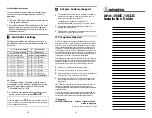
344 Optimizing fabric behavior
Figure 47
TI zone in an edge fabric
In the TI zone, when you designate E_Ports between the front and xlate phantom switches, you must use -1
in place of the “I” in the D,I notation. Both the front and xlate domains must be included in the TI zone.
Using D,I notation, the members of the TI zone in
Figure 47
are:
•
1,8
•
1,1
•
3,-1(E_Port for the front phantom domain)
•
4,-1(E_Port for the xlate phantom domain)
Note that in this configuration the traffic between the front and xlate domains can go through any path
between these two domains. The -1 does not identify any specific ISL. To guarantee a specific ISL, you need
to set up a TI zone within the backbone fabric.
TI within a backbone fabric
A TI zone within a backbone fabric is used to route traffic within the backbone fabric through a particular
ISL. For example, in
Figure 48
, a TI zone is set up in the backbone fabric to ensure that traffic between
EX_Ports 1,1 and 2,1 is routed through VE_Ports 1,4 and 2,7.
= Dedicated Path
-1
-1
Domain 1
Front Domain 3
Xlate Domain 4
Proxy Target
Host 1
Host 2
8
1
9
9
2
10
EX_Ports
E_Ports
= Ports in the TI zone
Summary of Contents for A7533A - Brocade 4Gb SAN Switch Base
Page 1: ...HP StorageWorks Fabric OS 6 2 administrator guide Part number 5697 0016 Edition May 2009 ...
Page 24: ...24 ...
Page 99: ...Fabric OS 6 2 administrator guide 99 ...
Page 100: ...100 Managing user accounts ...
Page 118: ...116 Configuring standard security features ...
Page 164: ...162 Configuring advanced security features ...
Page 234: ...232 Installing and maintaining firmware ...
Page 268: ...266 Administering advanced zoning ...
Page 284: ...282 Configuring Enterprise class platforms ...
Page 292: ...290 Routing traffic ...
Page 294: ...292 Interoperability for merged SANs ...
Page 302: ...300 Configuring the Distributed Management Server ...
Page 334: ...332 iSCSI gateway service ...
Page 340: ...338 Administering NPIV ...
Page 407: ...Fabric OS 6 2 administrator guide 405 ...
Page 408: ...406 Using the FC FC routing service ...
Page 438: ...434 Administering extended fabrics ...
Page 460: ...456 Administering ISL trunking ...
Page 516: ...512 FICON fabrics ...
Page 526: ...522 Configuring and monitoring FICON Extension Services ...
Page 540: ...536 Configuring the PID format ...
Page 544: ...540 Understanding legacy password behavior ...
Page 546: ...542 Mixed fabric configurations for non merge SANs ...
Page 550: ...546 Migrating from an MP Router to a 400 MP Router ...
Page 558: ...554 Inband Management ...
Page 572: ...568 ...
















































